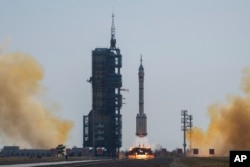China has launched the youngest-ever crew to space in its efforts to send astronauts to the moon.
The Jiuquan Satellite Launch Center, located in China, is responsible for launching satellites into orbit.
On Thursday, China sent its youngest team ever to its space station in orbit with the goal of putting astronauts on the moon by 2030.
At 11:14 a.m. (0314 GMT), the Long March 2-F rocket launched the Shenzhou 17 spacecraft from the Jiuquan Satellite Launch Center on the outskirts of the Gobi Desert in northwestern China.
The China Manned Space Agency reported that the three-person crew is the youngest to embark on the space station construction mission, as stated by state broadcaster CCTV. State media China Daily stated that their average age is 38.
Beijing is pursuing plans to place astronauts on the moon before the end of the decade amid a rivalry with the U.S. for reaching new milestones in outer space. This reflects the competition for influence between the world’s two largest economies in the technology, military and diplomatic fields.
Three individuals, Tang Hongbo, Tang Shengjie, and Jiang Xinlin, will take the place of a crew that has been aboard the space station for the past six months. Tang is an experienced astronaut who recently completed a three-month mission in 2021.
The agency stated that the new crew will perform experiments in space medicine and technology, as well as assist with the installation and upkeep of equipment both inside and outside the station during their mission.
The agency announced on Wednesday that they will be sending a new telescope to explore the vast depths of the universe. According to CCTV, the telescope will allow for extensive surveys and mapping of the sky, although no specific timeline was provided for its installation.
For centuries, China has studied the motion of stars and planets, but now it strives to be at the forefront of space exploration and scientific advances.
After being denied participation in the International Space Station, it constructed its own space station, mainly due to the United States’ apprehensions about the People’s Liberation Army, the armed force of the governing Communist Party, having too much influence over the program.
In 2003, China successfully completed its first crewed space mission, becoming the third country, after the former Soviet Union and the U.S., to independently launch a person into space.
At the moment, it is thought that the United States has a notable advantage over China in terms of expenditure, supply chains, and abilities. However, China has made advancements in certain areas, such as retrieving samples from the moon’s surface after many years and successfully landing a rover on the relatively unexplored far side of the moon.
The United States is working towards sending astronauts to the moon by the end of 2025, in a renewed effort to prioritize manned missions. This will be made possible with the help of private companies like SpaceX and Blue Origin.
Apart from their lunar initiatives, both nations have also independently sent rovers to Mars. China has announced plans to mimic the U.S. by landing a spacecraft on an asteroid.
Source: voanews.com




